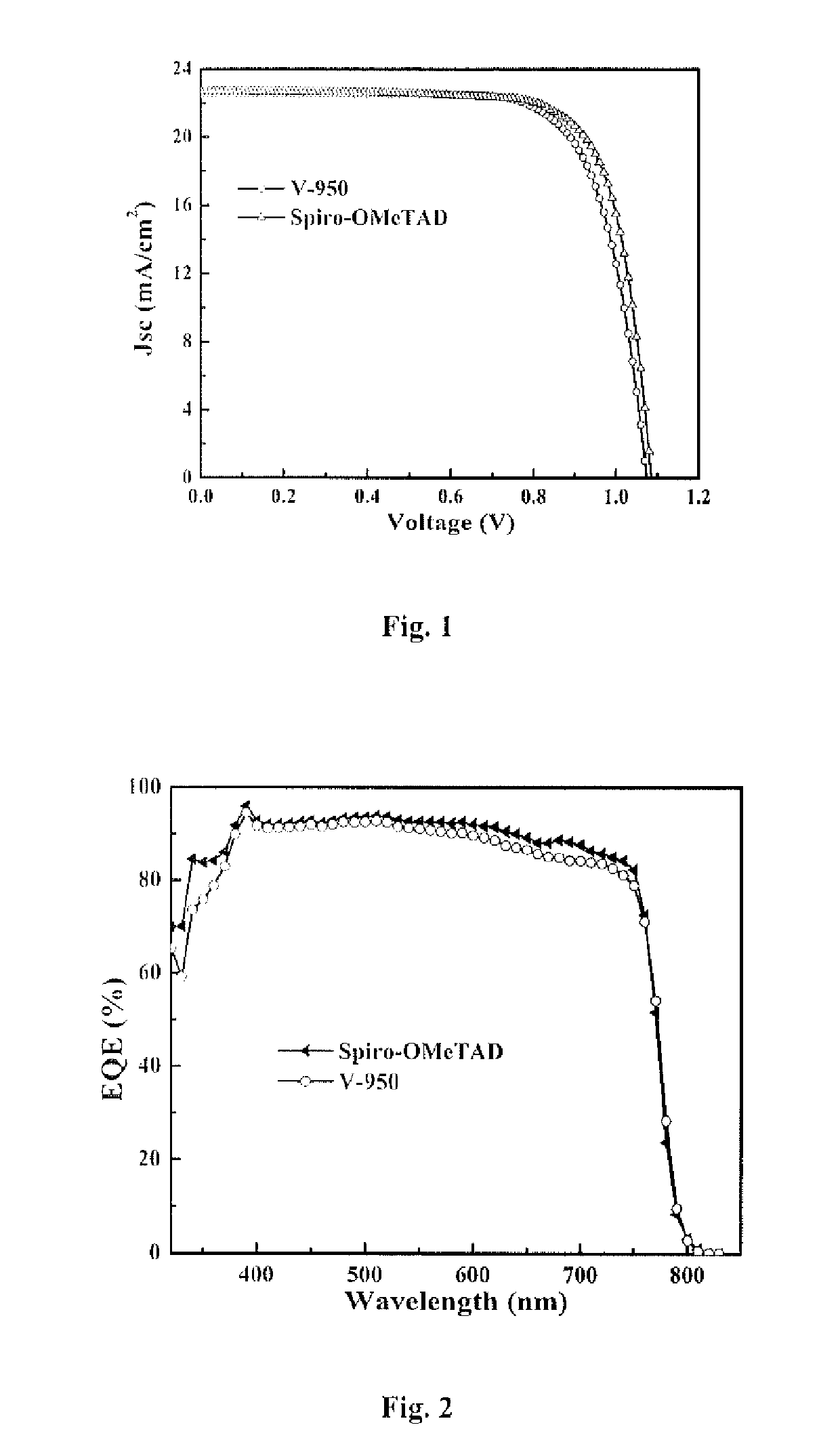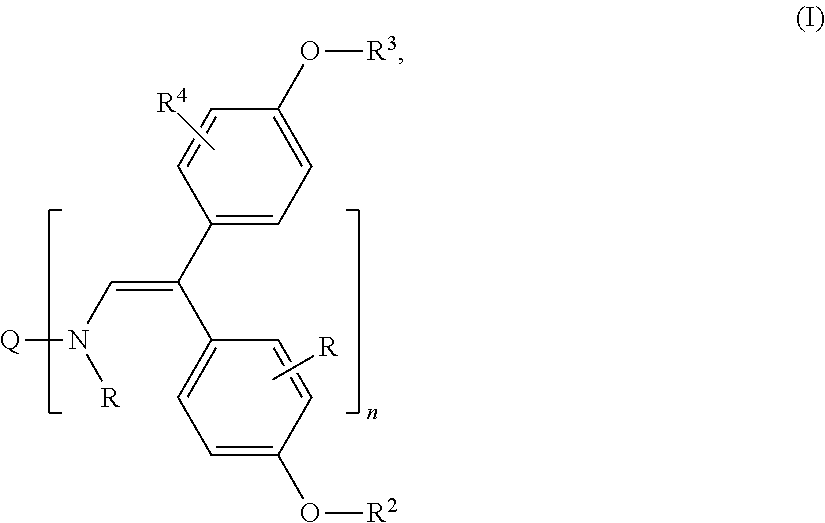Hole transporting organic molecules containing enamine groups for optoelectronic and photoelectrochemical devices
- Summary
- Abstract
- Description
- Claims
- Application Information
AI Technical Summary
Benefits of technology
Problems solved by technology
Method used
Image
Examples
example 1
9-ethyl-3-{N,N-bis[2,2-bis(4-methoxyphenyl)vinyl]amino}-9H-carbazole (See Scheme 1, Compound 1 or V-950)
[0057]
[0058]3-amino-9-ethylcarbazole (250 mg, 1.19 mmol) is dissolved in toluene (5 ml+volume of Dean-Stark apparatus), (+ / −)10-camphorsulfonic acid (276 mg, 1.19 mmol) was added and reaction mixture was refluxed for 20 min. Then 2,2-bis(4-methoxyphenyl)acetaldehyde (915 mg, 3.57 mmol) was added and reaction was continued using Dean-Stark apparatus for another 2 hours. After reaction was finished (TLC, acetone:n-hexane / v:v, 1:4) reaction mixture was extracted with ethyl acetate, organic layer dried with anhydrous Na2SO4, filtered and organic solvents removed in vacuum. The residue was dissolved in warm ethanol; formed crystals were filtered, washed with cold ethanol and recrystallized from the mixture of toluene:ethanol (1:2). Obtained crystals were dried under vacuum at 40° C. to yield 1 as yellow crystals (590 mg, 64%); m.p. 226-228° C.
[0059]1H NMR (700 MHz, DMSO-d6, δ): 8.15 (d...
example 2
9-butyl-3-{N,N-bis[2,2-bis(4-methoxyphenyl)vinyl]amino}-9H-carbazole (See Scheme 1, Compound 2 or V-1013)
[0062]
[0063]3-amino-9-butylcarbazole (1 g, 4.2 mmol) is dissolved in toluene (18 ml), (+ / −)10-camphorsulfonic acid (1 g, 4.3 mmol) was added and reaction mixture was refluxed for 20 min. Then 2,2-bis(4-methoxyphenyl)acetaldehyde (2.69 g, 10.5 mmol) was added and reaction was continued using Dean-Stark apparatus for another 1 hour. After reaction was finished (TLC, acetone:n-hexane / v:v, 1:4) reaction mixture was extracted with ethyl acetate, organic layer dried with anhydrous Na2SO4, filtered and organic solvents removed in vacuum. The residue was purified by column chromatography using THF: n-hexane / v:v, 1:49 and recrystallized from ethanol. Obtained crystals were dried under vacuum at 40° C. to yield 2 as yellow crystals (1.65 g, 55%).
[0064]1H NMR (400 MHz, CDCl3 δ): 8.05 (d, J=8.9 Hz, 1H, 5-H, Ht), 7.81 (s, 1H, 4-H, Ht), 7.44 (t, J=7.2 Hz, 1H, 6-H, Ht), 7.39-7.33 (m, 1H, 8-H, H...
example 3
9-hexyl-3-{N,N-bis[2,2-bis(4-methoxyphenyl)vinyl]amino}-9H-carbazole (See Scheme 1, Compound 3 or V-1001)
[0067]
[0068]3-amino-9-hexylcarbazole (1 g, 3.8 mmol) is dissolved in toluene (18 ml), (+ / −)10-camphorsulfonic acid (1 g, 4.3 mmol) was added and reaction mixture was refluxed for 20 min. Then 2,2-bis(4-methoxyphenyl)acetaldehyde (2.41 g, 9.4 mmol) was added and reaction was continued using Dean-Stark apparatus for another 1 hour. After reaction was finished (TLC, acetone:n-hexane / v:v, 1:4) reaction mixture was extracted with ethyl acetate, organic layer dried with anhydrous Na2SO4, filtered and organic solvents removed in vacuum. The residue was purified by column chromatography using acetone: n-hexane / v:v, 1:49 and recrystallized from ethanol. Obtained crystals were dried under vacuum at 40° C. to yield 3 as yellow crystals (1.56 g, 55%).
[0069]1H NMR (400 MHz, CDCl3 δ): 8.07 (d, J=7.7 Hz, 1H, 5-H, Ht), 7.8 (s, 1H, 4-H, Ht), 7.38 (d, 1H, J=8.2 Hz, 1H, 7-H, Ht), 7.33 (t, J=3.6 Hz,...
PUM
| Property | Measurement | Unit |
|---|---|---|
| Area | aaaaa | aaaaa |
| Area | aaaaa | aaaaa |
| Area | aaaaa | aaaaa |
Abstract
Description
Claims
Application Information
 Login to View More
Login to View More - R&D
- Intellectual Property
- Life Sciences
- Materials
- Tech Scout
- Unparalleled Data Quality
- Higher Quality Content
- 60% Fewer Hallucinations
Browse by: Latest US Patents, China's latest patents, Technical Efficacy Thesaurus, Application Domain, Technology Topic, Popular Technical Reports.
© 2025 PatSnap. All rights reserved.Legal|Privacy policy|Modern Slavery Act Transparency Statement|Sitemap|About US| Contact US: help@patsnap.com



